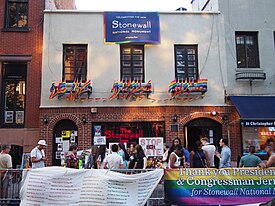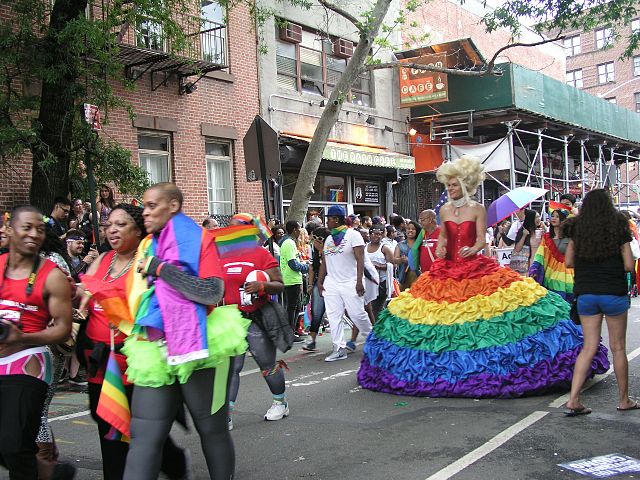The NYC Pride March is an annual event celebrating the LGBTQ community in New York City. The largest pride parade and the largest pride event in the world, the NYC Pride March attracts tens of thousands of participants and millions of sidewalk spectators each June,[4][5] and carries spiritual and historical significance for the worldwide LGBTQIA+ community and its advocates. Entertainer Madonna stated in 2024, "Aside from my birthday, New York Pride is the most important day of the year."[6] The route through Lower Manhattan traverses south on Fifth Avenue, through Greenwich Village, passing the Stonewall National Monument,[7] site of the June 1969 riots that launched the modern movement for LGBTQ+ rights.
| NYC Pride March | |
|---|---|
 The Stonewall Inn in Greenwich Village was the site of the June 1969 Stonewall riots. That event in New York City's queer history has served as a touchstone for various social movements, as well as the catalyst for Pride parades around the world.[1][2][3] | |
| Frequency | Annually, last Sunday in June |
| Location(s) | New York City, U.S. |
| Inaugurated | June 28, 1970, as part of Christopher Street Liberation Day |
| Next event | June 29, 2025 |
| Organized by | Heritage of Pride, since 1984 |

A central component of NYC Pride observances, the March occurs on the last Sunday in June.[8] An estimated 4 million attended the parade in 2019,[9] coinciding with the 50th anniversary of Stonewall, which drew 5 million visitors to Manhattan on Pride weekend.[10]
Origins
Early on the morning of Saturday, June 28, 1969, lesbian, gay, bisexual, and transgender (LGBT) people rioted, following a police raid on the Stonewall Inn, a gay bar at 53 Christopher Street in Greenwich Village, Lower Manhattan. This event, together with further protests and rioting over the following nights, marked a watershed moment in the modern LGBT rights movement and the impetus for organizing LGBT pride marches on a much larger scale. Veterans of the riot formed a group, the Stonewall Veterans Association, which has continued to drive the advancement of LGBT rights from the rioting at the Stonewall Inn, to the present day.
In the weeks following the riots, 500 people gathered for a "Gay Power" demonstration in Washington Square Park, followed by a march to Sheridan Square within the West Village.[11][12]
On November 2, 1969, Craig Rodwell, his partner Fred Sargeant, Ellen Broidy, and Linda Rhodes proposed an annual march to be held in New York City by way of a resolution at the Eastern Regional Conference of Homophile Organizations (ERCHO) meeting in Philadelphia.[13]
We propose that a demonstration be held annually on the last Saturday in June in New York City to commemorate the 1969 spontaneous demonstrations on Christopher Street and this demonstration be called CHRISTOPHER STREET LIBERATION DAY. No dress or age regulations shall be made for this demonstration.
We also propose that we contact Homophile organizations throughout the country and suggest that they hold parallel demonstrations on that day. We propose a nationwide show of support.[14][15][16][17]

All attendees to the ERCHO meeting in Philadelphia voted for the march except for Mattachine Society of New York, which abstained.[14] Members of the Gay Liberation Front (GLF) attended the meeting and were seated as guests of Rodwell's group, Homophile Youth Movement in Neighborhoods (HYMN).[18]
Meetings to organize the march began in early January at Rodwell's apartment in 350 Bleecker Street.[19] At first there was difficulty getting some of the major New York City organizations like Gay Activists Alliance (GAA) to send representatives. Craig Rodwell and his partner Fred Sargeant, Ellen Broidy, Michael Brown, Marty Nixon, and Foster Gunnison Jr. of Mattachine made up the core group of the CSLD Umbrella Committee (CSLDUC). For initial funding, Gunnison served as treasurer and sought donations from the national homophile organizations and sponsors, while Sargeant solicited donations via the Oscar Wilde Memorial Bookshop customer mailing list and Nixon worked to gain financial support from GLF in his position as treasurer for that organization.[20][21] Other mainstays of the organizing committee were Judy Miller, Jack Waluska, Steve Gerrie and Brenda Howard of GLF.[22] Believing that more people would turn out for the march on a Sunday, and so as to mark the date of the start of the Stonewall uprising, the committee scheduled the date for the first march for Sunday, June 28, 1970.[23] With Dick Leitsch's replacement as president of Mattachine NY by Michael Kotis in April 1970, opposition to the march by Mattachine ended.[24]
There was little open animosity, and some bystanders applauded when a tall, pretty girl carrying a sign "I am a Lesbian" walked by. – The New York Times coverage of Gay Liberation Day, 1970[25]
Christopher Street Liberation Day on June 28, 1970, marked the first anniversary of the Stonewall riots with a march from Sheridan Square, covering the 51 blocks to the Sheep Meadow in Central Park. The march took less than half the scheduled time due to excitement, but also due to wariness about walking through the city with gay banners and signs. Although the parade permit was delivered only two hours before the start of the march, participants encountered little resistance from onlookers.[26] The New York Times reported (on the front page) that the march extended for about 15 city blocks.[25] Reporting by The Village Voice was positive, describing "the out-front resistance that grew out of the police raid on the Stonewall Inn one year ago".[27] There was also an assembly on Christopher Street.
Organizers
The first March in 1970 was organized by the Christopher Street Liberation Day Committee.[28] Since 1984, the parade and related LGBT pride events in New York City have been produced and organized by Heritage of Pride (HOP), a volunteer spearheaded, non-partisan, tax-exempt, non-profit organization.[29] HOP welcomes participation regardless of age, creed, gender, gender identification, HIV status, national origin, physical, mental or developmental ability, race, or religion. HOP does not use qualifiers for participation.
In 2021, NYC Pride organizers announced that uniformed law enforcement would be banned from marching in the parade until 2025, when the ban will be reexamined by committees and the executive board of NYC Pride.[30][31]

Broadcast
For many years, the march was only available locally to Time Warner Cable customers, via its NY1 news channel. In 2017 WABC-TV broadcast the NYC LGBT Pride March live for the first time regionally, and made the stream available to all parts of the globe where such content is accessible.[32][33] WABC-TV continues to broadcast the first three hours of each years march (which has had an actual run time over nine hours in 2017 and 2018). Both the 2017 and 2018 broadcasts were Emmy nominated programs. In 2022, the WABC-TV broadcast was also available via streaming from ABC News Live and Hulu.
Schisms
Over the course of five decades, various groups have accused the NYC Pride March of losing its political, activist roots and becoming a venue for corporate pinkwashing, rainbow capitalism, and assimilation of queer identities.[34] Such critiques have given rise to various independent events conducted without permits or police. Since 1993 the NYC Dyke March has been held annually on the Saturday prior.[35] Since 1994 the New York City Drag March has been held annually on the Friday prior; it began as a protest against the ban on leather and drag during the 25th anniversary of Stonewall.[36][37] Coinciding with the 50th anniversary of Stonewall in 2019, the Reclaim Pride Coalition organized the first Queer Liberation March, held on Sunday morning, hours before the NYC Pride parade.[38][39]
Size
The first march, in 1970, was front-page news in The New York Times reporting the march extended for about fifteen city blocks.[25] The march had thousands of participants with organizers "who said variously 3,000 and 5,000 and even 20,000."[25] The variance could be due, in part, that although the march started with over a dozen homosexual and feminist contingents, parade spectators were encouraged to join the procession.[25] Currently, Heritage of Pride requires preregistration of marchers, and sets up barricades along the entire route discouraging the practice.[40]
Although estimating crowd size is an imprecise science, the NYC March is consistently considered the largest Pride parade in North America, with 2.1 million people in 2015, and 2.5 million in 2016.[41] In 2018, attendance was estimated around two million.[42] In 2024, the estimated crowd size was 2.5 million.[43] In 2019, as part of Stonewall 50 – WorldPride NYC, an estimated 5 million people took part over the final weekend of the celebrations,[44][45] with an estimated 4 million in attendance at the parade.[9][46] The 12-hour parade included 150,000 pre-registered participants among 695 groups.[47] It was the largest parade of any kind in the city's history and four times as large as the annual Times Square Ball on New Year's Eve.[48]
Grand marshals
2024
- Miss Major; Michelle Visage; Raquel Willis; and DaShawn Usher of GLAAD
- Youth Activist grand marshals: singer-songwriter Baddie Brooks, Hetrick-Martin Institute advocate Robin Drake, and content creator Eshe Ukweli[49][50]
2023
- Billy Porter; Yasmin Benoit, the first openly asexual Grand Marshal;[51] artist and educator AC Dumlao; Hope Giselle;[52] and Randy Wicker[53]
2022

- Ts Madison; Chase Strangio; Punkie Johnson; Schuyler Bailar; and Dominique Morgan of The Okra Project[54]
The COVID-19 pandemic in New York City resulted in cancelation of the 2020 and 2021 events.
2019: Stonewall 50

- Mj Rodriguez, Indya Moore, and Dominique Jackson from the cast of Pose; Phyll Opoku-Gyimah; Monica Helms, creator of the 1999 transgender pride flag; The Trevor Project; and the Gay Liberation Front[55]
2018
2017
- American Civil Liberties Union; Brooke Guinan, the first openly transgender FDNY firefighter; Krishna Stone of Gay Men's Health Crisis; Geng Le, Chinese LGBT rights leader and founder of Blued[57]
2016
- Jazz Jennings; Cecilia Chung;[58] and Subhi Nahas, refugee and cofounder of the first LGBT magazine in Syria
2015

- Ian McKellen; Derek Jacobi; Kasha Jacqueline Nabagesera; and J. Christopher Neal, the first openly bisexual Grand Marshal[59]
2014
2013
- Edith Windsor, plaintiff in United States v. Windsor, which struck down Section 3 of the Defense of Marriage Act;[60] Earl Fowlkes; and Harry Belafonte
2012
- Cyndi Lauper; Chris Salgardo of Kiehl's; Connie Kopelov & Phyllis Siegel, New York City's first legally married same-sex couple[61]
2011

- Dan Savage and Terry Miller, It Gets Better Project; Rev. Pat Bumgardner, Metropolitan Community Church of New York; and the Imperial Court of New York[62]
2010
- Constance McMillen; Judy Shepard; and Lt. Dan Choi[63]
2009: Stonewall 40
2008
- Gilbert Baker; Candice Cayne; New York Governor David A. Paterson; New York Senator Charles Schumer;[64] and NYC Mayor Mike Bloomberg[65]
See also
References
External links
Wikiwand in your browser!
Seamless Wikipedia browsing. On steroids.
Every time you click a link to Wikipedia, Wiktionary or Wikiquote in your browser's search results, it will show the modern Wikiwand interface.
Wikiwand extension is a five stars, simple, with minimum permission required to keep your browsing private, safe and transparent.
